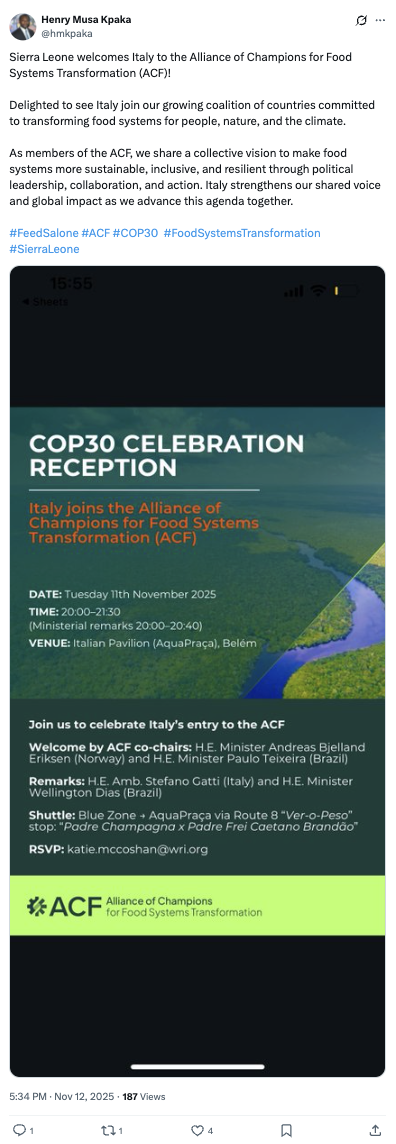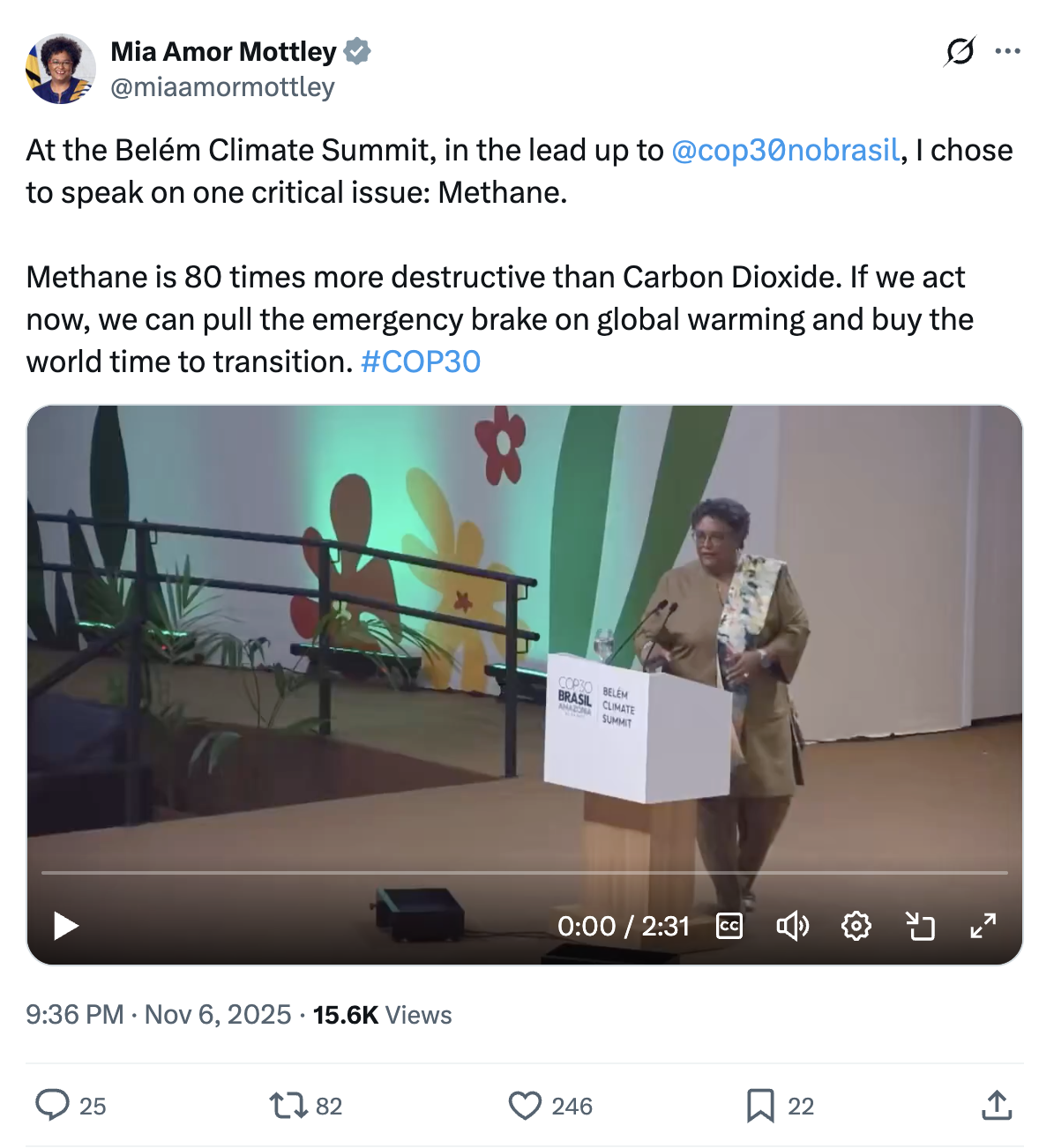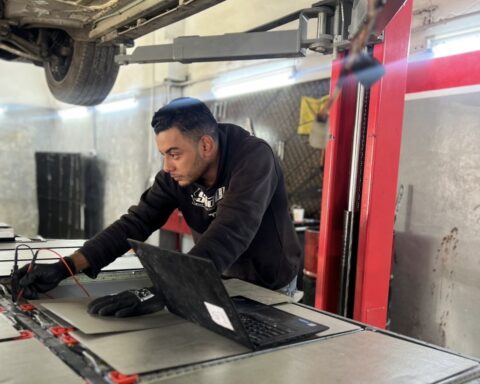The COP30 climate summit – held in the city of Belém, on the edge of the Amazon rainforest – saw the Brazilian presidency launch a new forest fund and promise a “roadmap” to put an end to deforestation.
Almost every country in the world signed off on a final COP30 package called the “global mutirão” – meaning “collective efforts” – after two weeks of talks ran into overtime amid deepening divisions, compromises and even a fire in the conference venue.
Countries also agreed on a set of indicators for countries to track their efforts on climate adaptation, including within the food and agriculture sectors.
Brazil’s much-anticipated tropical forest fund, launched just before COP30 officially began, raised $6.6bn, more than half of which will come from Norway and Germany.
In the second week of the negotiations, dozens of countries backed plans to agree on roadmaps to guide the move away from fossil fuels and deforestation.
Although these roadmaps did not make it into the final negotiated text, COP30 president André Corrêa do Lago said they will be developed outside the formal UN process.
The final mutirão text mentioned biodiversity loss, land rights and deforestation, but did not feature food – which disappointed some observers, including one expert who said food systems had been “erased” from COP30.
Meanwhile, the formal agriculture negotiations ended without a substantive outcome and talks are expected to continue next year.
Indigenous peoples featured strongly at COP30 and attended the summit in larger numbers than ever before. During the talks, $1.8bn was pledged for land rights and Brazil announced new Indigenous territories.
Below, Carbon Brief breaks down the main COP30 outcomes on food, forests, land and nature.
(See Carbon Brief’s coverage of key outcomes for food, forests, land and nature from COP29, COP28, COP27 and COP26.)
‘Global mutirão’
COP30 saw countries agree to a new “global mutirão” decision, a text calling for a tripling of adaptation finance by 2035 (later than some hoped), a new “Belem mission” to increase collective actions to cut emissions and – to the disappoint of many countries – no new “roadmaps” on transitioning away from fossil fuels and reversing deforestation. (See Carbon Brief’s snap analysis.)
“Mutirão” is a Portuguese word originating in the Indigenous Tupi-Guarani language that refers to people working together towards a common aim with a community spirit – something the COP30 presidency was keen to emphasise.
The presidency was also keen to stress that the mutirão text was not a cover text (sometimes referred to as a “cover decision”). However, like a cover text, it sought to bring together important issues that were not on the formal agenda with negotiated targets, acting as the key agreement from COP30.
The first draft of the mutirão put forward by the Brazilian presidency on 18 November included optional text to create a “high-level ministerial round table”, aimed at supporting countries to develop their own national roadmaps on transitioning away from fossil fuels and halting and reversing deforestation. (See: Deforestation roadmap.)
The language around this was criticised as weak by some observers, but its inclusion was widely welcomed.

The final mutirão decision did not mention fossil fuel or deforestation roadmaps. It did mention deforestation once, “emphasising” the importance of boosting efforts to halt and reverse deforestation by 2030 to help achieve the Paris temperature goal.
It noted that this is “in accordance with Article 5 of the Paris Agreement”, which is a section of the landmark climate deal that calls for strengthening of the world’s carbon sinks, including forests. (Carbon Brief understands that a large group of rainforest nations, called the Coalition of Rainforest Nations, were particularly keen to have Article 5 referenced in the final mutirão decision.)

The final mutirão decision makes multiple brief mentions of nature and the need to tackle climate change and biodiversity loss in a synergistic way.
Paragraph two of the agreement, in the section sometimes called the “preamble”, “emphasises” the importance of “conserving, protecting and restoring nature and ecosystem”.
Further down, in a section “recalling” the first global stocktake of climate action conducted at COP28 in Dubai in 2023, the text “underlines” the “urgent need to address, in a comprehensive and synergetic manner, the interlinked global crises of climate change, biodiversity loss, and land and ocean degradation in the broader context of achieving sustainable development”.
This inclusion likely reflects the presidency’s keenness to prioritise “synergies” between climate change, biodiversity loss and land degradation. (See: Climate and nature ‘synergies’.)
While the mutirão text included references to safeguarding Indigenous rights, conserving biodiversity and maintaining nature-based stores of carbon, no mention of food or agriculture appeared in any draft of the text.
Prof Raj Patel, a member of the International Panel of Experts on Sustainable Food Systems (IPES-Food), said in a statement that it was as if food systems were “erased” from the negotiations, adding:
“Two years ago, 160 countries signed a Declaration on Sustainable Agriculture with great ceremony. Today, they cannot bring themselves to mention the word ‘food’ in the mutirão decision.”
Adaptation
One of the major negotiated outcomes of the Belém summit was the agreement of a set of indicators for countries to measure their progress towards the global goal on adaptation (GGA).
The GGA, agreed at COP28 in Dubai, sets out 10 targets for countries to measure their progress towards, including targets on water scarcity, climate-resilient food systems and reducing climate impacts on ecosystems.
The initial list of indicators for these targets numbered 10,000. These had been whittled down by experts since COP28 and, at COP30, negotiators were tasked with agreeing on just 100 for countries to use.
Divisions were apparent from the first day of COP30, with the African group and Arab group proposing a two-year period for refining the GGA indicators before formally adopting them in 2027, according to the Earth Negotiations Bulletin. This move was opposed by several other blocs, including the Independent Alliance of Latin America and the Caribbean (AILAC) and the EU.
Disagreements arose between countries on the need for finance in order to implement the GGA, whether indicators infringed on countries’ sovereignty and indicators around domestic financing.
Richard Muyungi, African group chair, told Carbon Brief in the first week:
“We need to put guardrails or caveats on the adoption [of the indicators]. For example…the indicators should not infringe on the sovereignty of countries, asking countries to change their laws, their strategies. I mean, you cannot ask my country to change laws, because they want to address the global goal.”
Ultimately, countries adopted a set of 59 indicators and agreed to a two-year work programme “aimed at developing guidance for operationalising the Belém adaptation indicators”.
The set included five indicators on assessing progress towards climate-resilient and sustainable food systems.
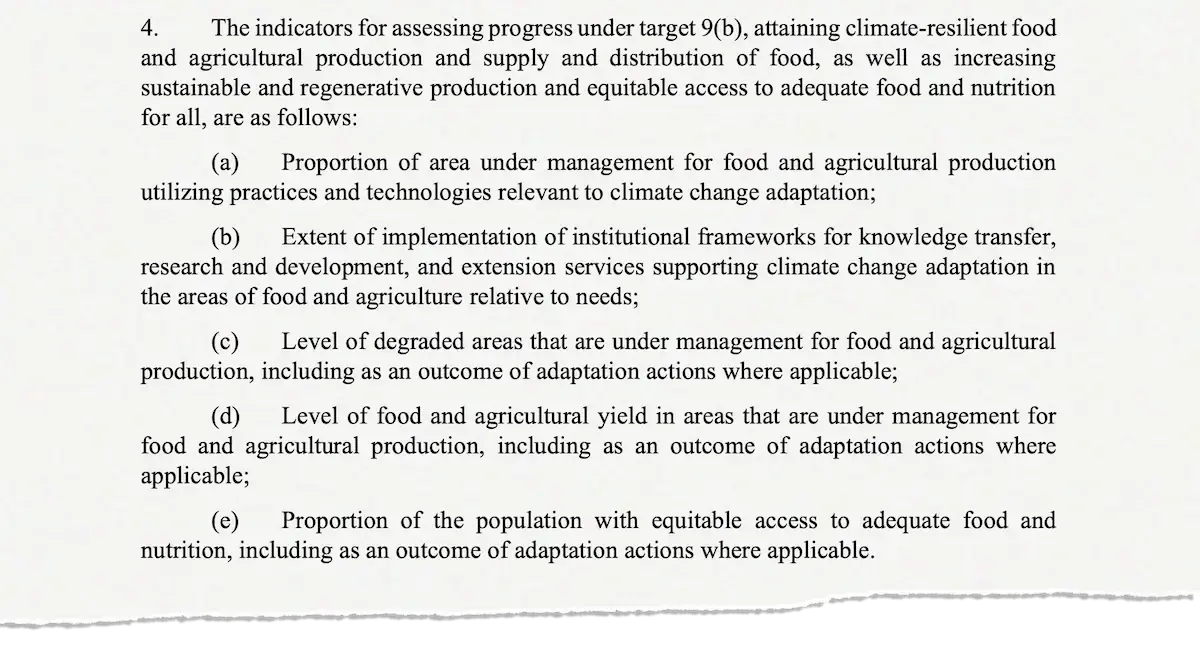
The indicators on ecosystems and biodiversity included measuring the proportion of ecosystems “providing services to populations that depend on them”, the level of adaptive capacity due to the implementation of nature-based solutions and the levels of threat status of ecosystems and species.
However, observers noted that the indicators were heavily caveated, with the introductory text of the agreement “emphasis[ing]” their voluntary nature.

(For more on adaptation and the GGA, see Carbon Brief’s explainer of COP30’s key outcomes.)
Tropical Forest Forever Facility and other forest pledges
At the COP30 leaders’ summit, Brazil officially launched the Tropical Forest Forever Fund to “reward” countries that conserve their tropical forests.
During the negotiations, the facility raised $6.6bn and had the support of 53 countries, including countries with tropical forests and those that will act as investors.
This instrument is intended to be a financial vehicle to raise $125bn from countries, philanthropy and private investors, which will then be invested in the global bond market. It is intended to be able to support up to 74 countries that have tropical forests across many regions, such as the Amazon and the Congo Basin.
The TFFF has been described as “the largest forest-finance mechanism ever created” and praised by Brazil’s finance minister, Fernando Haddad, as “innovative” for combining public and private financing.
However, it has also received criticism.
As Carbon Brief has previously reported, experts have concerns around fragmenting existing climate finance and inadequate accountability. Other criticisms have focused on worries that the fund could benefit investors over forest countries and that 20% of the funds being directed to Indigenous peoples is insufficient.
For Sandra Guzmán, founder and general director of the Climate Finance Group for Latin America and the Caribbean (GFLAC), the Brazilian government focused on moving forward with the TFFF and neglected other aspects of financing, such as the Baku to Belém roadmap to mobilise $1.3tn per year in climate finance by 2035. She told Carbon Brief:
“The TFFF is not a mechanism that has been agreed upon multilaterally. [If the fund fails in its mission], it would only confirm that Brazil could have [capitalised] on other funds that are within the [UN climate] convention and do have a future.”
After the launch of the TFFF, it was rejected by 150 civil society groups and Indigenous peoples’ organisations, who said the fund “does not seek to address the true structural causes of forest destruction” and “does not prioritise Indigenous peoples and local communities”.
The COP30 presidency stated that, in the second week of negotiations, governments, multilateral funds and Indigenous leaders met to discuss how an Indigenous governance model – known as Dedicated Grant Mechanism (DGM) – can “inform and strengthen the emerging generation of climate finance facilities”.
Analysis by the civil society organisation Leave it in the Ground (LINGO), presented at COP30, suggested that not extracting fossil fuels beneath forests eligible for the TFFF would prevent 4.6tn tonnes of CO2 from being released.
These emissions would be saved if countries “were to adopt a pledge of no fossil-fuel extraction in its forests”, the report said.
Kjell Kǘhne, director of LINGO, said in a press conference attended by Carbon Brief that while restrictions on fossil fuels are not part of the scope of the discussions of the TFFF, this would make it “even stronger”.
Other forest funds
Elsewhere at COP30, countries renewed their COP26 commitment to help protect rainforests in the Congo Basin, which contains the world’s second-largest area of tropical forest.
A Belém “call to action” pledged to raise more than $2.5bn for the cause over the next five years. This was put forward by Gabon and France and signed by Germany, Belgium, Norway and the UK, alongside development banks and other groups.
A new pledge of $1.8bn was put forward from more than 35 governments and philanthropic organisations to help secure land rights across forests and other ecosystems for Indigenous peoples, local communities and Afro-descendent communities, according to the Forest & Climate Leaders’ Partnership. (See: Indigenous representation.)
The UK also announced almost £17m in funding for the Accelerating Innovative Monitoring for Forests (AIM4Forests) programme, a cooperation between the UN Food and Agriculture Organization (FAO) and the UK that supports countries in monitoring and reporting on forests.
Meanwhile, Brazilian development bank BNDES approved R$250m (£35m) for ecological restoration and tree-management projects in parts of the Amazon and Atlantic forests, Brazilian outlet InfoMoney reported, adding that the funding will help to recover up to 19,000 hectares of forest land.
On 17 November, when forests featured as one of the COP30 themes of the day, more than 70 civil-society groups called on governments to set up forest “fossil-free zones” – areas where oil, coal and gas are not extracted – to protect forests and the rights of Indigenous peoples and local communities.
Earlier that week, Colombia said it was the first Amazonian nation to keep its entire Amazon forest area “free from oil and mining activities”, InfoAmazonia reported.
Countries that hold the Amazon rainforest, including Brazil, Peru and Colombia, also launched an initiative, called Amazonia Forever, to gather more than $1bn to invest in Amazonian infrastructure and cities.
Brazil’s planning and budget minister, Simone Tebet, said this programme for cities and resilient infrastructure would “enable us to take action not only on forest and water resources, but also on urban challenges”.
Agriculture and food security
With agribusiness giant Brazil hosting this year’s summit, many expected COP30 to have a stronger focus on agriculture and food than previous years.
Formal negotiations for agriculture and food systems under the UN climate convention fall under the Sharm el-Sheikh joint work on the implementation of climate action on agriculture and food security (SJWA). COP30 ended without a substantive outcome for the SJWA.
The current four-year mandate of SJWA – which runs workshops, is developing an online portal and prepares an annual synthesis report of agriculture-relevant work undertaken by UN climate convention bodies – began in 2022 and runs out at COP31 next year.
At COP30, the main points of discussion for countries were a consideration of the outcomes of a workshop on “systemic and holistic approaches” to implementing climate action on food and agriculture, as well as countries weighing in on a special forum of the standing committee on finance (SCF) on financing for sustainable food systems and agriculture.
As the summit got underway in Belém, several parties began pushing the idea of capturing key messages from the workshop and forum into a formal SJWA decision.
Observers told Carbon Brief that Argentina, the African group and the least-developed countries (LDCs) wanted “means of implementation” – shorthand for finance – added to the text, while the EU opposed references to “Article 9.1” in the agriculture workstream. (See: Climate finance in Carbon Brief’s main COP30 outcomes piece.)
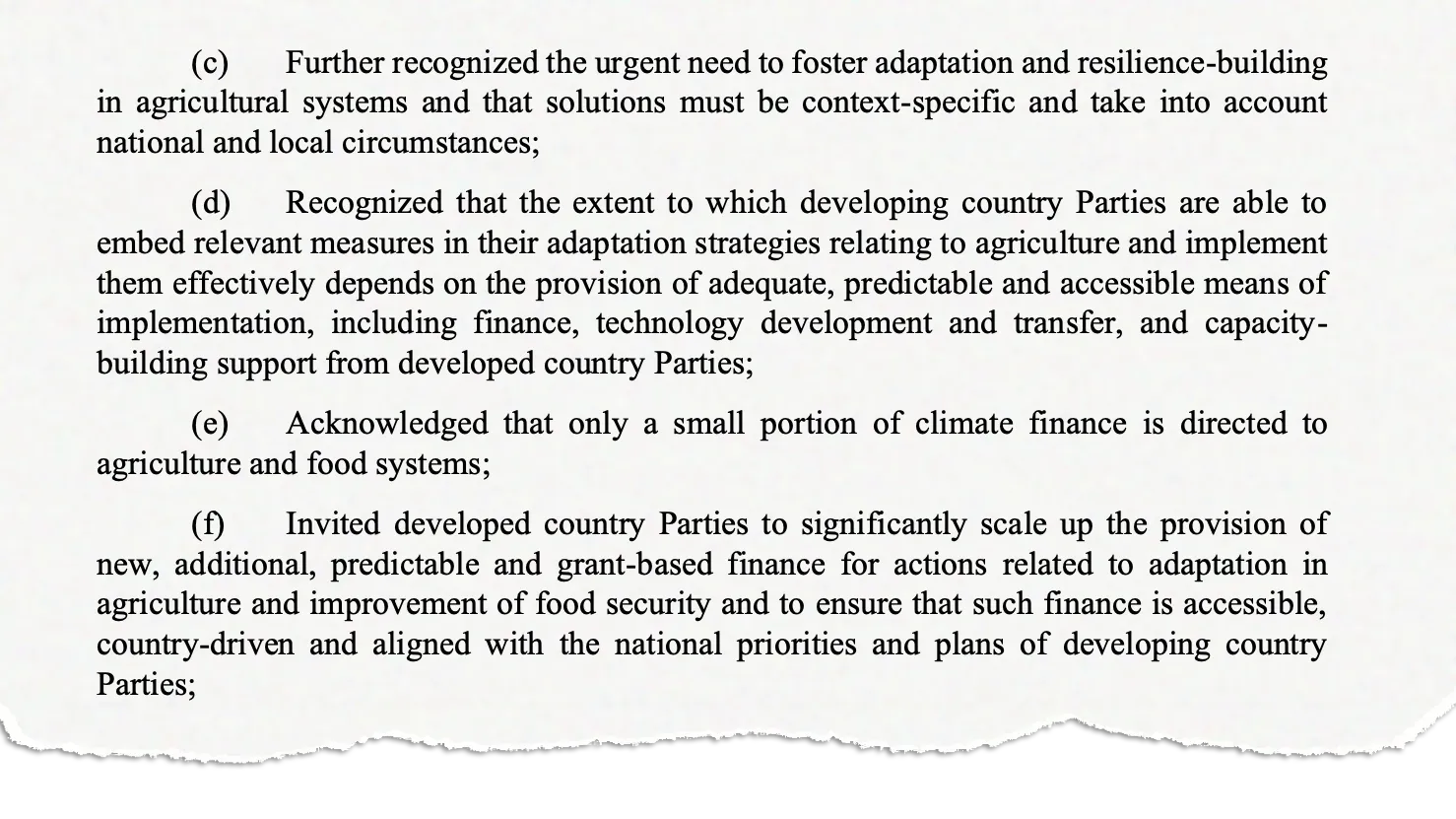
The next day, various blocs circulated text proposals on recognising the workshop outcome. These texts, seen by Carbon Brief, included proposals from the EU and the Environmental Integrity Group (EIG) on food systems “which span the entire value chain”, links to biodiversity, “precision agriculture” and market-based rewards for farmers.
G77 and China, meanwhile, flagged 13 points for inclusion in the draft text, including recognising the “fundamental priority of ending hunger” and a call for developed countries to “significantly scale up…grant-based finance for adaptation actions in agriculture”.
Language from all of these proposals was incorporated into a draft text released on the first Thursday of COP30.
This draft – with 23 square brackets, indicating text not yet agreed – included many references, ranging from agroecology to AI-farming and using “high-integrity carbon-market approaches under Article 6” to reward farmers.
It also recognised that the World Trade Organization (WTO) “can be useful in ensuring a stable, predictable global agricultural trade underpinned by rules” that support climate action.

Five hours later, this was replaced by a brief draft, which postponed further discussions until June next year, taking into account the earlier text.
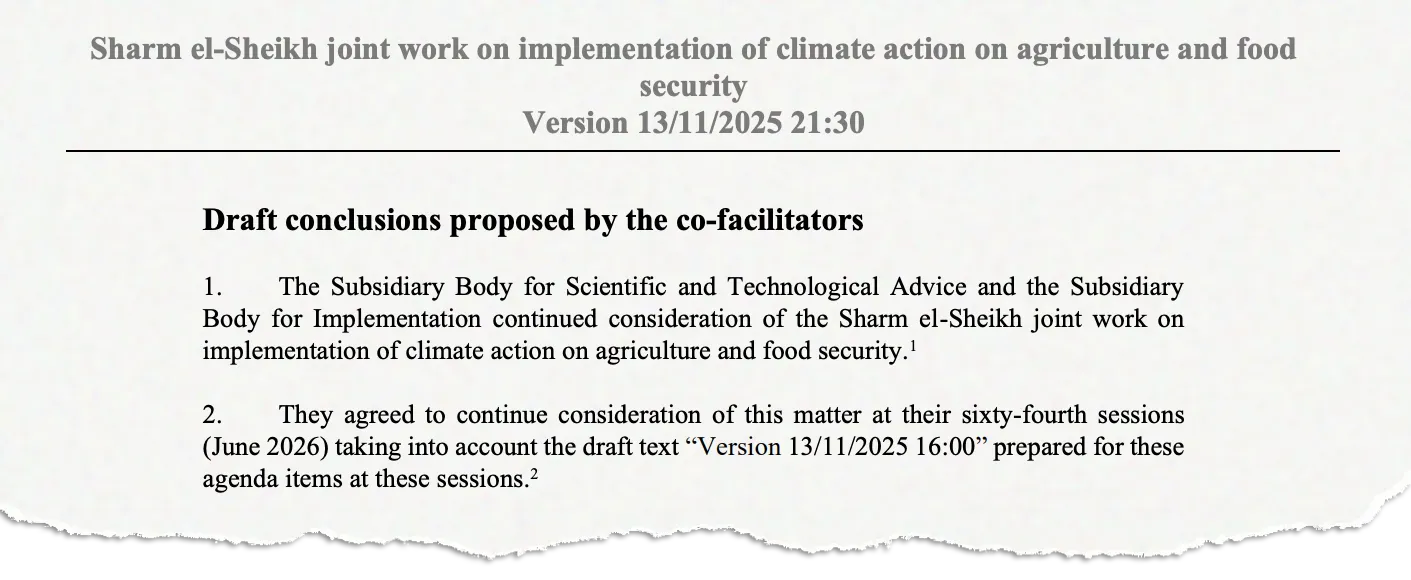
Many observers expressed their dismay at negotiations finishing so abruptly, before the end of week one and without a substantive outcome.
Teresa Anderson, global climate justice lead at Action Aid International, told Carbon Brief that negotiations “took a turn for the worse” after Australia and the EIG “pushed for dodgy language” on what could be considered “systemic” and “holistic”. Anderson said:
“In June, many countries talked about agroecology. And yet here in the COP, Australia and others just submitted language on precision agriculture, on AI and just basically a lot of corporate greenwash…Countries weren’t able to agree on [this] because there was just too much new nonsense in there.”
The final draft conclusions “recognised that progress was made at these sessions” and “noted that more time is needed to conclude the discussions thereon”.
Article 6
Carbon markets – particularly relating to forests – were expected to be a key priority for the Brazilian presidency at COP30.
On 7 November, the Brazilian presidency launched a global coalition on “compliance carbon markets”, endorsed by 18 countries.
The voluntary initiative said it is designed to allow members to “share experiences and learn from each other”. It also said the coalition will “explore options to promote interoperability of compliance carbon markets in the long term”.
Finally, it mentioned information exchange on the “potential use of high-integrity offsets”, referencing a sector that has faced intense scrutiny in recent years.
The same day, Honduras and Suriname announced a deal to issue “high-integrity rainforest carbon credits” in partnership with Deutsche Bank, German agrochemical giant Bayer and the Coalition for Rainforest Nations (CfRN).

Formal negotiations on carbon trading under Article 6 of the Paris Agreement were expected to be somewhat muted, but ended up being rather complicated.
In Baku last year, countries had finally agreed on the rules for country-to-country carbon trading under Article 6.2 and for a new international Paris Agreement carbon market under Article 6.4, bringing a decade of negotiations to a close. Countries also agreed to undertake a review of these rules in 2028.
Within the Article 6.4 market, key tools for “nature-based” removals and rights safeguards were still being developed after COP29 by the “supervisory body” in charge of standards.
At COP30, negotiations focused on the annual report of this body, which had been given autonomy to set these standards at COP29.
The supervisory body had recently adopted a standard on non-permanence on 10 October, which had been the subject of heated debate in the sector.
The standard describes how to handle the risk of someone selling carbon credits for a project that removes CO2 from the atmosphere, only for this stored carbon to be released back into the atmosphere. This is a phenomenon known as “reversal” and is particularly pertinent for tree-planting projects, which may be at risk from wildfires and drought.
In a joint letter published on 12 November, a group of NGOs and carbon-trading advocates said this and other standards “could exclude all land-based activities”, such as forests, from the Article 6.4 market.
They called for new guidance to be given to the supervisory body to prevent this from happening. Their recommendations on amending the rules around reversal risk to give more scope to include nature-based projects – which were opposed by some scientists and other NGOs – were picked up and reflected in an early draft text at COP30.
This text, published on 14 November, asked the market’s supervisory body to “consider carbon market forecasts” and revise its standards so as not to “discourage the development” of nature-based solutions.
At the same time, text options “urging” the body to make its decisions more transparent and “minimise time in closed-door sessions” were heavily bracketed.

In response to this draft text, Isa Mulder of Carbon Market Watch told Carbon Brief:
“All of the pro-market flexibility in there [would] completely undermin[e] the Paris Agreement.”
On 15 November, Climate Action Network awarded Indonesia its “Fossil of the Day” for repeating “lobbyists’ talking points” surrounding weaker rules on the permanence of nature-based credits – “sometimes verbatim” – in its intervention in Article 6.4 negotiations.
While explicit references to nature and nature-based carbon crediting projects were removed in a second draft issued late on 15 November, the text still asked the body to apply a “tailored approach” and weigh the “economic feasibility” of its standards.
In the end, references to these two terms were also dropped. Many countries saw the effort to give detailed guidance to the supervisory body as an attempt to “micro-manage” its work, creating uncertainty for market actors.
The final decision on Article 6.4 gave carbon-credit projects registered under the “clean development mechanism” (CDM) a six-month deadline extension, until June 2026, to “transition” into the Paris Agreement’s new carbon market.
In theory, this could allow up to another 760m tonnes of CO2-equivalent of credits to enter the Paris Agreement regime.
The final Article 6.4 decision “averted disaster” and could potentially make the UN-backed carbon market “marginally” more inclusive, according to Carbon Market Watch, which added that these improvements “do little to change the rather worrying course that Article 6 seems to be on”.
The decision “reiterates” that supervisory body members should not have “any financial or other interests” that could affect – or be seen to affect – their impartiality.
It also “requests” that the body strengthen its consultation processes by informing, reaching out to and including Indigenous peoples, local communities and others who “cannot easily participate” in the complex mechanism.
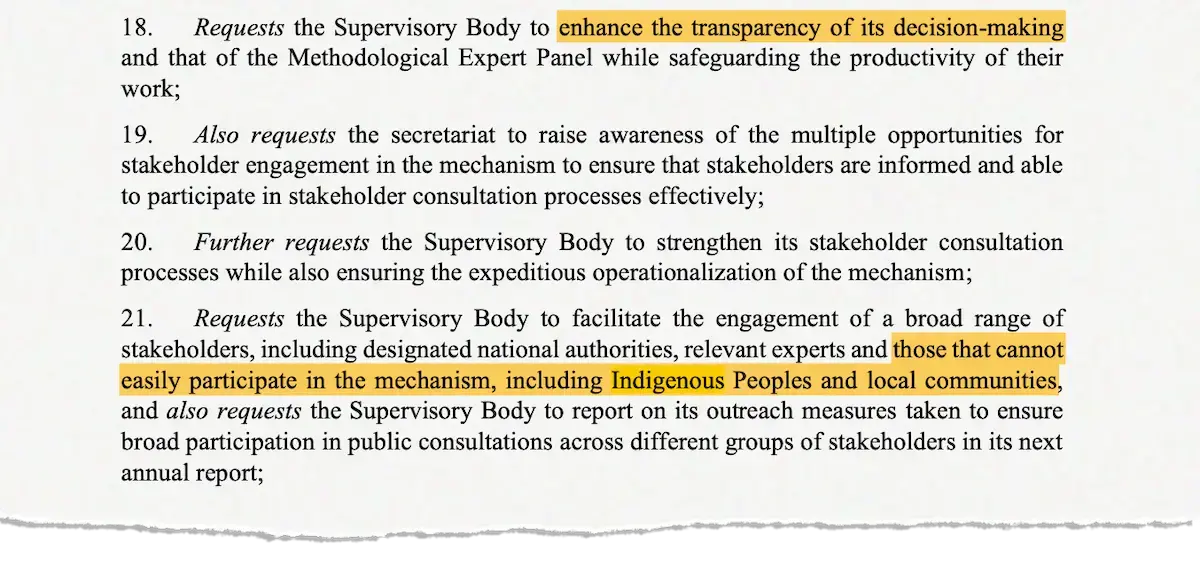
While there are fewer rules that govern country-to-country carbon trading under Article 6.2, countries were supposed to submit “initial reports” of these bilateral carbon-trading deals for review by technical experts ahead of COP30.
The first six reviews – including a Swiss-supported project to promote “climate-smart” rice cultivation in Ghana and sustainable forest management in Guyana and Suriname – were completed ahead of the summit.
A particular issue being considered at COP30 was the fact that, to date, “all trades” under Article 6.2 so far have been flagged with “inconsistencies” during expert review.
The COP30 Article 6.2 decision simply “notes” these inconsistencies and “urges” countries to sort them out, while adding that the reporting and review process is still “in the early stages”. It also asks reviewers to “clearly explain” any issues they find and how to resolve them.

Deforestation roadmap
During the Belém talks, momentum began to build around agreeing a roadmap to end deforestation, although it was largely overshadowed by the push for a similar fossil-fuel phase-out plan.
At COP26, more than 130 countries had signed on to a non-binding pledge to halt and reverse deforestation by 2030. This pledge was formally recognised in the global stocktake agreed at COP28. Although the rate of deforestation is decreasing, countries are off track to meet this goal.
A roadmap aimed to help achieve this deforestation target did not appear in the final mutirão decision agreed at COP30. However, in the closing plenary of the summit, Corrêa do Lago said the Brazilian presidency would work to create deforestation and fossil-fuel roadmaps outside the COP negotiation process.
In a speech at the opening of the leaders’ summit before COP30 began, Lula had called for roadmaps to “reverse deforestation, overcome dependence on fossil fuels and mobilise the resources required to achieve these goals in a fair and planned manner”.
By the second week of negotiations, around 45 countries backed a deforestation roadmap, including Brazil, Colombia, Mexico, the EU and the Democratic Republic of the Congo, according to a Carbon Brief tracker. This increased to at least 92 countries by Friday 21 November, after a large group of more than 50 rainforest nations got behind the proposal.
WWF and Greenpeace had urged countries to adopt the deforestation roadmap “as a formal outcome at COP30”, while Colombia’s environment minister, Irene Vélez-Torres, wrote in Backchannel, a climate commentary platform:
“We need to see the global north come behind a roadmap – and quickly.”
However, the final text signed off on 22 November did not include mentions of either roadmap. (See: ‘Global mutirão’.)
Although more than 90 countries backed the deforestation roadmap, “wider political will to secure this in Belém was lacking”, WWF said in a statement.
Carolina Pasquali, executive director of Greenpeace Brazil, said that Lula’s government had “set the bar high” in calling for deforestation and fossil-fuel roadmaps, but the “divided multilateral landscape was unable to hurdle it”.
After the talks ended, Prof Nathalie Seddon, the director of the nature-based solutions initiative at the University of Oxford, said in a statement:
“Until we have coupled roadmaps for ending deforestation and phasing out fossil fuels, grounded in rights and direct finance for those who safeguard ecosystems, we will remain off track for a safe and just future.”
‘Unilateral trade measures’
After several failed attempts to bring climate-related “unilateral trade measures”, such as the EU’s deforestation regulation, onto the agenda at previous COPs, the issue was taken up in Belém as part of presidency-led discussions and reflected in the key outcome of the summit, the “global mutirão”.
This decision creates three annual “dialogues” on trade, to be held at the Bonn intersessional meetings in 2026, 2027 and 2028. It also “reaffirms” that climate measures, “including unilateral ones, should not constitute” trade restrictions that are “arbitrary” or “discriminat[ory]”.
This is the first-ever mention of trade measures in a COP cover decision.
While the issue of trade has received a significant level of attention at recent summits, it is not a new one for the UN climate regime. The text agreed in Belém, below, precisely repeats the language in article 3.5 of the 1992 UN climate convention.
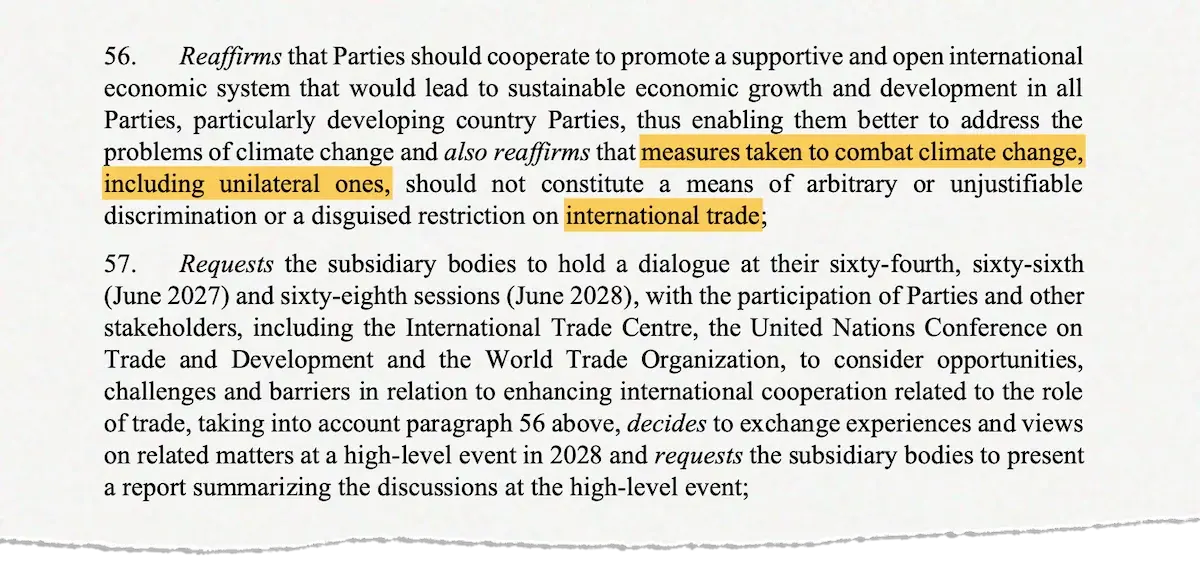
In Belém, the issue of such measures had once again been raised by Bolivia on behalf of the like-minded developing countries (LMDCs, a group that includes China, India and others).
Within the presidency-led consultations, the LMDCs called for a recurring agenda item on trade, Tuvalu supported a dialogue and the African group proposed a system for countries to report new trade measures to the UN climate convention, according to the Earth Negotiations Bulletin.
On Sunday in the middle of COP, the presidency published a summary of its consultations, containing five options for a decision on trade measures, including dialogues, roundtables or the creation of a platform.

David Waskow, director of the international climate initiative at the World Resources Institute thinktank, told a media briefing that trade is a “real issue” for some countries and not just a “bargaining tactic or some sort of chit that’s being put on the table”.
He added that the EU “feels strongly” about the ways trade measures support climate action, but developing countries have “real concerns” about how those measures play out.
Avantika Goswami, climate-policy lead at Delhi-based thinktank the the Centre for Science and Environment, told Carbon Brief that, while it is “not ideal to not have a formal agenda item” on unilateral trade measures, the reference to the UN climate convention in the text “is welcomed”, as well as the dialogues that will take place over the next three years. Goswami added:
“At the very least, this will elevate the issue of unilateral trade measures to be more high-profile within the COP space and will provide a forum for countries to discuss their concerns and challenges, as well as possible solutions for the way forward.”
Alongside the discussions under the presidency, these measures continued to crop up within different negotiation streams, including on just transition, “response measures” and technology.
The final decision on the just transition work programme removed all references to trade, although it recognised the role of smallholder farmers and food production.

Anderson, from ActionAid, told Carbon Brief that civil society had “fought hard” to make sure food and farmers were included in the just transition discussion. She told Carbon Brief:
“We’ve been calling for a just transition in agriculture because agriculture is the [second biggest] polluter after fossil fuels, and the [biggest] employer in the world.
“We know we need to transition in agriculture, but it has to be fair to protect jobs, livelihoods, families, communities and global food security. That is really, really important, because we know there’s a lot to learn from many years of climate action that hasn’t always put rural communities, who are often marginalised, first in the conversation.”
Biofuels

On 14 October, at the pre-COP in Brasilia, the Brazilian presidency launched the Belém 4x pledge, which aimed to gather high-level support to quadruple the production and use of “sustainable fuels” – such as hydrogen and biofuels – by 2035, as compared to 2024 levels.
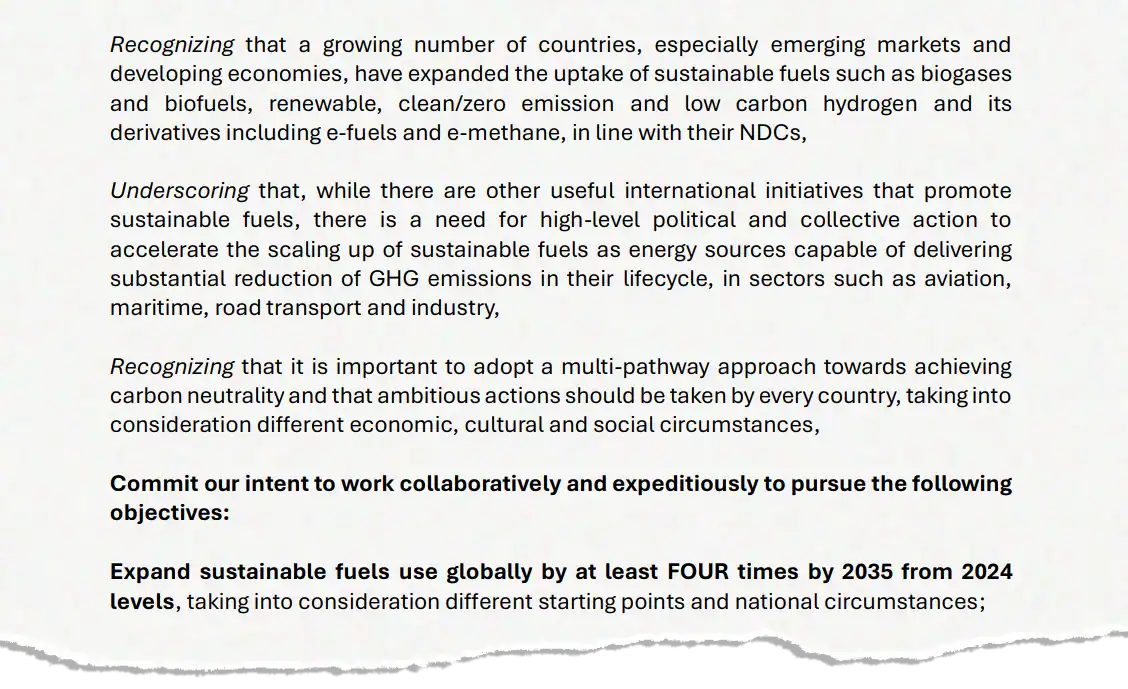
The pledge was co-sponsored by Italy and Japan, supported by India and has been backed by 23 countries so far, including Canada and the Netherlands. On 14 November, Brazil announced a partnership with the Clean Energy Ministerial to “advance Belem 4x”.
However, the pledge was “rejected” by some NGOs, including Climate Action Network and Greenpeace, who criticised the environmental, social and food security impacts of biofuels.
Hikmat Soeriatanuwijay at Oil Change International said in a statement:
“The Belém 4x pledge uses the language of sustainability to justify continued fossil-fuel use. The [Intergovernmental Panel on Climate Change] states that forest protection will have the highest mitigation value; however, exploitation of natural forests and cropland for bioenergy undermines this priority.”
The 4x pledge was based on the International Energy Agency’s report on “delivering” sustainable fuels, which included “woody biomass” being converted into biofuels.
However, the IEA report also warned that, for fuels to be considered sustainable, they “need to comply” with other criteria, “such as preservation of biodiversity, sustainable water management and compliance with social safeguards”.
In a statement from the Climate Land Ambition and Rights Alliance (CLARA), former Tasmanian Greens leader Peg Putt from the Biomass Action Network called the pledge’s promotion of liquid and gaseous fuels derived from wood a “dangerous distraction”. Putt said:
“The combustion of wood for bioenergy releases massive amounts of stored greenhouse gases immediately and the myth of its carbon neutrality is based on flawed accounting that ignores the decades forests need to regrow, if they ever do. The true carbon cost rarely appears on any national balance sheet.”
Many observers feared that biofuels would be included in the negotiations or in COP30’s cover decision.
As of an 18 November informal note, elements for a decision on the just transition work programme still referred to the role of “transitional fuels”.
That term has no officially agreed definition, although many states believe that it covers bioenergy and biofuels.

This option was deleted from draft text published on 21 November, and is not reflected in the final just transition work programme decision.
The final global mutirão decision also had no explicit mention of biofuels, transitional fuels or sustainable fuels.
Food systems and water
Transforming food systems and agriculture was one of the six “pillars” on the COP30 “action agenda”, but many observers were disappointed with the outcomes on food in Belém.
Food solutions were “on display” at COP30 – in the form of local dishes served to delegates and new pledges announced – but “none of this made it into the negotiating rooms or the final agreement”, said Dr Elisabette Recine, a member of the International Panel of Experts on Sustainable Food Systems (IPES-Food). She added in a statement:
“Despite all the talk, negotiators failed to act, and the lived realities of those most affected by hunger, poverty and climate shocks went unheard.”
Outside the formal negotiations, a number of new pledges were announced, including the Belém declaration on hunger, poverty and human-centered climate action, which aims to address the “unequal distribution of climate impacts”.
This was adopted by 43 countries and the EU and focused on a number of actions, including supporting climate adaptation for small farmers and expanding social-protection systems, such as government unemployment and illness pay. The German cooperation and development minister described it as a “pioneering step in linking climate action, social protection and food security”.
The UN Environment Programme (UNEP) launched a food waste initiative to help halve food waste by 2030 and also target a reduction in methane emissions of up to 7%, as food waste is a source of the potent greenhouse gas. (See: Methane.)
The food waste pledge was backed by Brazil, Japan and the UK, alongside several cities and private companies, and included goals for governments to integrate food waste into climate and biodiversity plans.

The thematic days for food and agriculture on 19 and 20 November saw a raft of other new announcements, including Brazil launching the resilient agriculture investment for net-zero land degradation (RAIZ).
This initiative is aimed at bringing together governments and investors to restore degraded farmland. It was backed by 10 countries, including the UK, Australia and Saudi Arabia.
An FAO press release said RAIZ will help governments to attract more funding and allocate investment towards restoring agricultural land. No specific financial goal was mentioned, but Bruno Brasil from Brazil’s ministry of agriculture said in a statement that it could “unlock billions globally to restore degraded farmland, protect biodiversity and ensure food security”.
Brazil and the UK also put forward a declaration to spur action around reducing the environmental impact of fertilisers. This expressed “intent” to prioritise sustainable production of fertilisers and improved nutrient management, alongside recognising that improper use of fertilisers “threaten[s] our ecosystems and food systems”.
Additionally, some initiatives launched at previous COPs were updated in Belém. Colombia, Italy and Vietnam joined the Alliance of Champions for Food Systems Transformation – a coalition of countries pledging to take strong action on transforming food systems that was first launched at COP28.
A number of reports released during the talks looked at how food systems were included in countries’ climate plans, called “nationally determined contributions”, or NDCs. A report from WWF and Climate Focus found that 93% of new NDCs included at least one measure around agriculture or food systems, an increase from 86% of previous pledges.
Another NGO assessment of how food systems were incorporated into 10 NDCs found that pledges from Somalia and Switzerland were “very strong” in this regard and included actions from across the entire food system. Climate pledges from Brazil and New Zealand, on the other hand, were ranked as “weak”, the report said.
Sebastian Osborn from Mercy for Animals, one of the organisations involved in the assessment, told a press conference:
“Overall, countries are not fully embracing the potential benefits of incorporating food systems into their climate policies.”
Elsewhere, the Gates Foundation put forward $1.4bn for smallerholder farmer climate adaptation in sub-Saharan Africa and south Asia. The Rockefeller Foundation announced more than $5.4m to “strengthen the resilience” of food systems and provide children’s school meals.
In terms of water and ocean outcomes, six more countries joined the “blue NDC challenge”, an initiative launched by Brazil and France earlier this year that encourages nations to integrate ocean measures into their climate pledges.
Finally, analysis from the World Resources Institute, Ocean & Climate Platform and Ocean Conservancy found that more than 90% of new NDCs submitted by coastal and island countries included ocean-based climate actions, an increase from 73% in 2022.
Climate and nature ‘synergies’
Some hoped that a first-of-its-kind outcome on jointly addressing climate change, biodiversity loss and land degradation could emerge from COP30.
However, in the end, pushback from some nations scuppered plans for a new “synergies” agreement.
At the Rio Earth summit in 1992, the world decided to address Earth’s most pressing environmental problems under three separate conventions: one on climate change, one on biodiversity and the final one on land desertification.
But, for the past few years, a growing number of scientists, politicians and diplomats have questioned whether tackling these issues separately is the right approach.
And, at the most recent biodiversity and land desertification COPs, countries agreed to new texts calling for closer cooperation between the three Rio conventions.
Speaking at a side event on nature at COP30, Juan Carlos Monterrey, Panama’s hat-sporting special climate envoy, said that countries committed a “big sin” when they decided to “decided to split the environment into three different structures”.
(Panama has plans to be the first country to publish one document that will function as both its climate plan – known as a “nationally determined contribution” (NDC) – and its nature plan – known as a “national biodiversity strategy and action plan” (NBSAP).)
After pledging to make COP30 a “nature COP”, the presidency held consultations on an agenda item called “cooperation with other international organisations”, with the hopes of producing the first substantive outcome on addressing climate change, biodiversity loss and land degradation together.
A draft “areas of interest” text linked to the issue spoke of “creat[ing] a space for continuous discussions to enhance cooperation among the Rio conventions” and the “establishment of a process to come up with a set of recommendations on how to enhance cooperation and policy coherence”.
However, several nations, including Saudi Arabia, vocally opposed the progression of a substantive outcome – and the final version of the “synergies” text is just five paragraphs long, containing little that is new.
Observers pointed out to Carbon Brief that Saudi Arabia’s opposition was particularly puzzling, given it currently holds the presidency for the desertification COP.
In an interview with Carbon Brief, Dr Osama Faqeeha, deputy environment minister for Saudi Arabia and chief adviser to the COP16 desertification presidency, said that the nation did not support any action that might lead to “dissolving the conventions”.
When pressed on whether, as the COP16 desertification presidency, it should be prioritising more “synergistic” work between the three Rio conventions, Faqeeha added:
“We have to realise the convention is about land. Preventing land degradation and combating drought. These are the two major challenges.”
Bethan Laughlin, a senior policy specialist at the Zoological Society of London, said the final synergies text “fell short of the high ambition championed by many countries and civil society”, but does offer some hope for future collaboration. She told Carbon Brief:
“This agenda item may not have had a substantive outcome in the text, but it also did not fail. Countries have committed to continued dialogue and collaboration, moving [the agenda item] beyond its previous relegation as a brief annual intersessional discussion – towards meaningful political engagement.”
Indigenous representation
COP30 achieved several milestones for Indigenous peoples, including securing recognition of their land rights in the mutirão decision and agreeing on a just transition mechanism that ensures that Indigenous peoples rights are included.
Belém’s climate summit was attended by more than 3,000 representatives of Indigenous peoples, making it the largest participation of Indigenous peoples in the history of COPs.
However, Cultural Survival – a not-for-profit organisation that supports Indigenous rights worldwide – said in a statement that this COP was “one of the most frustrating and disappointing” for Indigenous peoples. It noted that only 14% of 2,500 Indigenous representatives from Brazil received accreditation to access the official negotiations area.
Fany Kuiru, general coordinator of the Coordinator of Indigenous Organisations of the Amazon Basin (COICA), told Carbon Brief that some Indigenous representatives felt discontent due to a lack of “full and effective” participation.
On the second day of COP30, dozens of Indigenous protesters clashed with security guards in order to enter the negotiations and demand climate action and forest protection.
Emil Gualinga, a member of the Kichwa Peoples of Sarayaku, in Ecuador, said in a press release that Indigenous peoples continue to be excluded from negotiation rooms and most of their proposals were not incorporated into final decisions.
In Belém, Brazil’s minister of Indigenous peoples, Sonia Guajajara called for the mutirão text to integrate the demarcation of Indigenous lands as a climate policy.
Indigenous peoples viewed this statement as “quite positive”, Toya Manchineri, general coordinator of the Coordination of Indigenous Organisations of the Brazilian Amazon (COIAB), said at a press conference attended by Carbon Brief.
Currently, few countries’ climate plans recognise the territorial rights of Indigenous peoples as climate instruments, according to a recent report that analysed the NDCs of 15 countries in Latin America, Africa and Asia.
One of the major outcomes of COP30 for Indigenous peoples was the commitment to allocate $1.8bn to support Indigenous peoples and Afrodescendants’ tenure rights from 2026 to 2030 as part of the Forest and Land Tenure Pledge. Another finance-related outcome was the establishment of the Tropical Forest Forever Facility, which guarantees that 20% of its funds will go to Indigenous groups. (See: Tropical Forest Forever Facility and other forest pledges.)
Additionally, 15 countries committed to a collective target to recognise and secure land tenure of 160m hectares by 2030 for Indigenous peoples and Afro-descendant communities. Brazil announced the demarcation of 10 new Indigenous territories and acknowledged that 59m hectares must be secured over the next five years.
The preamble of the mutirão decision also recognised Indigenous rights, including their land rights and traditional knowledge.

Gualinga, the Ecuadorean Indigenous leader, said in a press release that this recognition was an “important step forward and it gives us tools to continue advocating for our rights in future decisions”.
However, he noted that Indigenous groups had proposed more robust language in the mutirão text, such as including their full and effective participation in the development and implementation of NDCs, as well as direct access to financing.
Indigenous peoples also demanded that the climate finance received by countries must include their traditional knowledge and “explicit guarantees” of principles such as free, prior and informed consent, legal security of land, Indigenous land tenure and complaint mechanisms, Kuiru told Carbon Brief.
She added that Indigenous communities have their own mechanisms for managing funds and that “have already demonstrated to be efficient”, which is why they advocate for direct funding to Indigenous peoples.
Indigenous peoples around the world have struggled to receive such funding directly. Only 0.7% of climate finance provided to developing countries mentions the word “Indigenous”, a new study by the International Institute for Environment and Development (IIED) found.
The mutirão decision ultimately did not include direct access to climate finance for Indigenous peoples.
Methane
Methane – the potent greenhouse gas that is the second-biggest contributor to global warming, after CO2 – featured in several COP30 pledges and announcements, but overall did not make major waves in Belém.
A UNEP report released during the summit looked at countries’ progress towards meeting the voluntary global pledge to reduce methane emissions by 30% by 2030, which has been backed by almost 160 countries since its launch at COP26.
The report found that while progress has been made on the extent of the increase in methane, emissions are still rising each year. Based on current government pledges, methane emissions will reduce by 8% by 2030, but they could reduce by 32% with more ambition and “full implementation of existing technically feasible reductions”, the report found.
Martin Krause, the director of the climate-change division at UNEP, said at the report’s launch that drastically cutting methane is “like pulling the climate emergency brake”, saying countries should “pull that brake hard and fast”.
Caitlin Smith at the Changing Markets Foundation campaign group said in a statement that to make progress on cutting methane, governments must “ramp up action on agriculture – the biggest source of methane, yet a blind spot for most rich countries”.
Research from thinktank Planet Tracker – released just before COP30 – found that 52 of the world’s largest meat, dairy and rice companies emit a combined 22m tonnes of methane every year.
The report also found that only seven of these 52 companies directly report the distribution and scale of their methane emissions and just one – Danone – has a specific methane-reduction target.
Also during the talks, the Changing Markets Foundation launched an interactive tool tracking agricultural methane emissions from companies and countries around the world.
Meanwhile, Farmers Weekly reported that the UK government “quietly shelved” plans to announce a national pledge to cut livestock methane emissions by 30% by 2030.
The UK, Brazil and China hosted a methane summit on the weekend before talks officially began. During this event, the Climate and Clean Air Coalition launched an “action accelerator” to help governments in developing countries cut emissions from super pollutants, including methane.
Brazil, Cambodia, Nigeria and four other countries have been initially chosen for this initiative and will receive a combined $25m to “advance their efforts in this area. The plan aims to work with up to 30 countries by 2030 and gather around $150m in funds. Additionally, 11 countries signed a statement committing to “drastically reducing” fossil methane emissions.
Other measures were announced in Belém, including a joint strategy to boost methane reductions across the agriculture, energy and waste sectors in developing countries, launched by the Global Methane Hub and the Global Green Growth Institute.
This initiative will focus on Mexico, Nigeria and Senegal, a statement said.
On 19 November, a scheme to boost efforts to cut methane and nitrous oxide emissions from agriculture was launched. The farmers’ initiative for resilient and sustainable transformations (FIRST) aims to help countries in Latin America, Africa and Asia share “practical, low-cost solutions that cut emissions, strengthen food security and improve resilience”, a statement from the Climate and Clean Air Coalition said.
Some funding was also put forward for tackling methane, with businessman Mike Bloomberg announcing $100m in investment towards methane-cutting efforts, such as satellite monitoring of leaks of the gas.
Bloomberg told a press briefing attended by Carbon Brief that methane is an “extremely important part of the climate puzzle”.
Agricultural greenwashing
Brazil is a major producer of soya beans, beef, rice, biofuels and many other agricultural products. As a result, observers and media outlets were keenly watching out for any instances of agribusiness-related greenwashing or lobbying at COP30.
Before the negotiations began, DeSmog published a list of eight “big ag greenwashing terms” to watch out for in Belém. These included phrases such as regenerative agriculture, as well as arguments around fossil fuels and ways of measuring methane emissions.
The outlet published a number of other articles during the talks, reporting (alongside the Guardian) that more than 300 agricultural lobbyists attended COP30, mapping out the food and farming companies and trade groups at COP30 and detailing the social media influencers “enlisted” by agribusiness companies ahead of the talks.
“Sustainable” claims around biofuels also came under scrutiny in Belém. DeSmog identified nearly 60 events on the benefits of biofuels at COP30, led by both industry groups and related companies.
These included a “high-level event on the critical role of biofuels” and a “sustainable biofuels” section in the summit’s action agenda.
Unearthed reported that a COP30 sustainable agriculture pavilion, located around 2km outside the official “blue zone” where negotiations took place, was “sponsored by agribiz interests linked to deforestation and anti-conservation lobbying”.
Campaigners protested against “big agriculture lobbyists” outside this “AgriZone” pavilion during the negotiations, the Grocer said.
The Associated Press said the pavilion sought to “spread a message of lower-carbon agriculture possibilities”, but added that “industrial agriculture retains a big influence at the climate talks”.
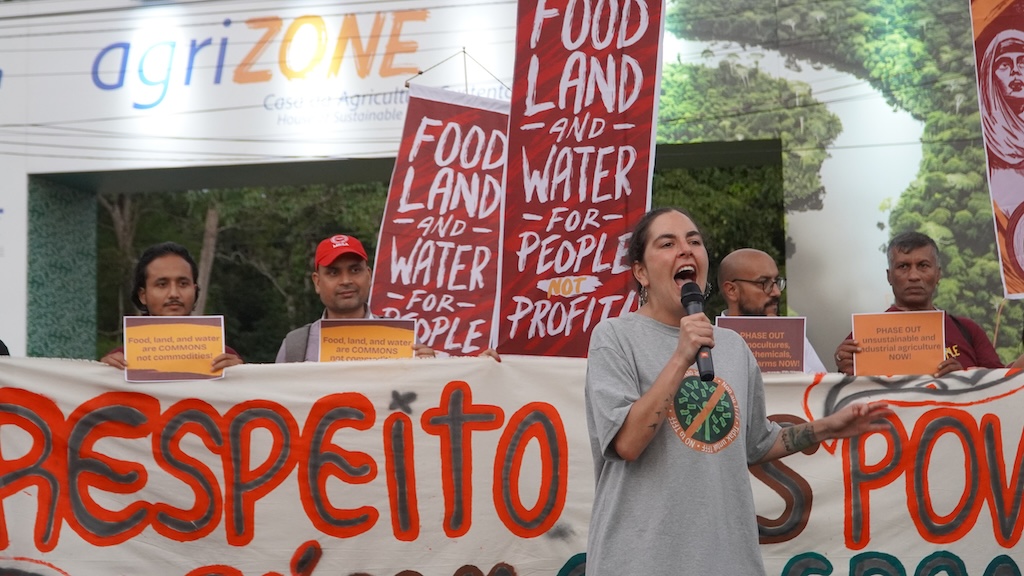
Brazilian outlet Agência Pública, meanwhile, reported that Brazil placed the “billionaire brothers” who own JBS, the world’s largest beef producer, on a “VIP list” at COP30.
The Changing Markets Foundation also published a report looking at COP30 events led by the agriculture industry and assessing Brazil’s “agricultural methane blind spot”.
Teresa Anderson, global climate justice lead at Action Aid, told Carbon Brief that agribusiness was the “elephant in the room” at COP30. She added:
“We’ve had this COP set in the Amazon, with the Brazilian presidency, talking a big game on forests, but absolute crickets when it comes to naming the biggest threat to forests, which is big industrial agriculture.”
The post COP30: Key outcomes for food, forests, land and nature at the UN climate talks in Belém appeared first on Carbon Brief.
COP30: Key outcomes for food, forests, land and nature at the UN climate talks in Belém
Climate Change
UK budget 2025: Key climate and energy announcements
UK chancellor Rachel Reeves has announced new measures to cut energy bills alongside a “pay-per-mile” electric-vehicle levy as part of Labour’s second budget.
The policy changes are expected to cut typical household bills by around £134 per year, amid intense political scrutiny of energy prices and a government pledge to reduce them.
This cut is achieved through a combination of moving a portion of renewable-energy subsidies from bills to general taxation and ending a support scheme for energy-efficiency measures.
Reeves has also retained a long-standing freeze on fuel-duty rates on petrol and diesel, albeit with a plan to “gradually” reverse the extra cuts introduced under the previous government.
With fuel-duty receipts set to fall as people opt for electric vehicles, the government has also laid out its plan for an “electric vehicle excise duty” from 2028, to replace lost revenue.
The government has also announced new “transitional energy certificates” to allow new oil and gas production at or nearby to existing sites, as part of its plan for the future of the North Sea.
Below, Carbon Brief runs through the key climate- and energy-focused announcements from the budget.
- Energy bills
- Electric vehicles
- Fuel duty
- North Sea oil and gas
- Nuclear, ‘green finance’, critical minerals and rail
Energy bills
The chancellor used her budget speech to announce two major changes that will cut dual-fuel energy bills for the average household by £134 per year from April 2026.
The first is to bring the “energy company obligation” (ECO) to an end, once its current programme of work wraps up at the end of the financial year. This will cut bills by £63 per year, according to Carbon Brief analysis of the forthcoming energy price cap, which will apply from 1 January 2026.
The second is for the Treasury to cover three-quarters of the cost of the “renewables obligation” (RO) for households, for three years from April 2026. This will cut bills by £70 per year.
The total impact for typical households – those using gas and electricity – will be to cut bills by an average of £134 per year over the three-year period to April 2029.
(As explained in footnote 77 of the budget “red book”, this rises to an average of £154 per year, when including households that use electric heating and are not connected to the gas grid. This figure is then rounded to £150 per year in government communications around the budget.)
Notably, given the political attention on energy prices, this three-year period of discounted bills runs through to just before the next general election, which must be held by August 2029.
There has been furious debate over the past year over the causes and the most effective solutions to the UK’s high energy bills. A Carbon Brief factcheck published earlier this year showed that it was high gas prices, rather than net-zero policies, which has been keeping bills high.
Nevertheless, a politicised debate has continued and there has also been increasing attention on the factors that will put pressure on bills in the near future, such as efforts to strengthen the electricity grid.
At the same time, the advisory Climate Change Committee (CCC) has repeatedly advised the government that it should make electricity cheaper, as so much of the UK’s climate strategy depends on getting homes and businesses to use electricity for heat and transport.
The changes in the budget will go some way to addressing this.
Carbon Brief calculations show that they would cut unit prices for domestic electricity users by around 4p per kilowatt hour (kWh) – roughly 16% – from 28p/kWh under the next price-cap period from the start of 2026, down to around 23p/kWh.
However, the red book says the government wants to further “improve” the price of electricity relative to gas, often referred to as “rebalancing”. It explains:
“The government is committed to doing more to reduce electricity costs for all households and improve the price of electricity relative to gas…The government will set out how it intends to deliver this through the ‘warm homes plan’.”
Under ECO, which has been in place since 2013, utility firms must install energy efficiency measures in fuel-poor homes, funded by a levy on energy bills.
It replaced two earlier schemes, known as CERT and CESP, with reduced funding after then-prime minister David Cameron reportedly told ministers to “get rid of the green crap”. This shift coincided with a precipitous decline in the number of homes being treated with new efficiency measures.
The ECO scheme has been hit by a series of scandals, with a recent National Audit Office report citing “clear failures” in its design, resulting in “widespread issues with the quality of installations”.
Pre-budget media reports had speculated that the government would pay for ongoing energy efficiency initiatives after scrapping ECO, using funding from the forthcoming “warm homes plan”. This speculation had suggested that subsidies for heat pumps would be cut as a result.
Instead, the budget includes an extra £1.5bn of funding for the warm homes plan, to cover the additional cost of taking over from ECO. (The total cost of ECO was around £1.7bn.)
Adam Bell, head of policy at the consultancy group Stonehaven and the government’s former head of energy policy, tells Carbon Brief that, while this £1.5bn is not the total cost of ECO, the scheme had been “terribly inefficient”. He adds that a government-run alternative that tackles home upgrades on an area-by-area basis was “likely to be cheaper”.
Contrary to much pre-budget speculation in the media, the chancellor did not reduce the already-discounted 5% rate of VAT on energy bills. Nor did she scrap the “carbon price support”, a top-up carbon tax on electricity generators.
Finally, the budget red book says that the government “recently confirmed” an increase in the level of relief for certain industrial users, from electricity network charges.
It says that, in total from 2027, the “British industrial competitiveness scheme” will cut electricity costs for affected businesses by £35-40 per megawatt hour.
Electric vehicles
The budget confirmed the introduction of a new “pay-per-mile” charge for electric vehicles, to raise more than £1bn in additional tax revenue by the end of this decade.
It has long been expected that fuel-duty receipts will begin to fall as electric vehicles start making up a rising share of cars on the road.
In its report accompanying the budget, the Office for Budget Responsibility (OBR) forecasts a decline to around half of current levels in the 2030s in real terms, before falling to near-zero by 2050.
As such, the new charge on EVs will help maintain road infrastructure, the budget states. The “red book” notes that the new tax will see EV drivers paying a “fair share”. It adds:
“All vehicles contribute to congestion and wear and tear on the roads, but drivers of petrol and diesel vehicles pay fuel duty at the pump to contribute their fair share, whereas drivers of electric vehicles do not currently pay an equivalent.”
The electric vehicle excise duty (eVED) will come into effect in April 2028 at a rate of 3p per mile for battery electric vehicles and 1.5p per mile for plug-in hybrid cars, according to the OBR report.
The budget red book says this will mean the average driver of a battery electric vehicle paying “around £240 per year”. This is roughly half of the rate of fuel duty paid per mile by petrol and diesel car owners. (See: Fuel duty.)
(EVs will remain significantly cheaper to run than their combustion-engine equivalents. According to the Energy and Climate Intelligence Unit thinktank, EVs would still be £1,000 cheaper to run per year than petrol equivalents, even after the new eVED charge.)
Currently, there is no equivalent to fuel duty for electric vehicles. Excise duty was brought in for EVs for the first time in April 2025, costing £10 for the first year and then rising to a standard rate of £195 per year – an increase announced in last year’s budget.
The introduction of the eVED is expected to raise £1.1bn in 2028-29 and £1.9bn in 2030-31, dependent on electric-vehicle uptake in the coming years.

The revenue generated by the eVED will “support investment in maintaining and improving the condition of roads”, the budget adds, with the government committing to £2bn in annual investment by 2029-30 for local authorities to repair and renew roads.
A consultation will be published seeking views on the implementation of eVED, the budget notes. It adds that there will be no requirement to report where or when the miles are driven, or to install trackers in cars.
The OBR report states that the additional charge of the eVED “is likely” to reduce demand for electric cars, due to increasing their lifetime costs.
Overall, it estimates that there will be around 440,000 fewer electric car sales across the forecast period relative to its previous forecast.
New support for EV buyers and manufacturers also announced in the budget could help offset 130,000 of this impact, the report notes.
This includes a boost to the electric car grant, which was launched in July and currently offers up to £3,750 off eligible vehicles.
The budget announces an increase of £1.3bn in funding for the programme, as well as an extension out to 2029-30.
Additional measures include an increase in the threshold at which EV owners have to pay the “expensive car supplement” from £40,000 to £50,000 from April 2026. This is expected to cost the government £0.5bn in 2030-31, the OBR notes.
The government will delay changes to “benefit-in-kind” (BIK) rules for employee car-ownership schemes until April 2030. This is a continuation of a policy announced in Reeve’s first budget as chancellor in 2024, which delayed the previously planned increase in BIK rates to 9% per year for electric vehicles by 2029, instead increasing them to just 2% per year out to 2029-30.
EV manufacturers will see the research and innovation Drive35 programme extended, with a further £1.5bn allocated to the project to 2035. This takes total funding for the project to £4bn over the next 10 years, according to the government.
Beyond the vehicles, the budget includes investment for EV charging infrastructure – also partly funded through the eVED revenues, it notes – with an additional £100m allocated. This builds on the £400m announced in the spending review in June.
Additionally, funding will be allocated to local authorities to support the rollout of public chargepoints, a consultation will be launched on permitting rights for cross-pavement EV charging and a 10-year 100% business-rates relief for eligible EV chargepoints will be introduced.
Fuel duty
Former Conservative governments repeatedly cancelled inflation-linked increases in fuel duty – a tax paid on petrol and diesel – every year since 2010.
Fuel duty was cut by an additional 5p per litre in 2022 by then-Conservative chancellor Rishi Sunak in response to the energy crisis.
Successive freezes in fuel duty have substantially increased the UK’s carbon dioxide (CO2) emissions by lowering the cost of driving and, therefore, encouraging people to use their cars more and low-carbon transport options less.
Last year, Reeves opted to maintain the existing freezes and cuts introduced by her predecessors.
In the new autumn budget, she has once again announced a freeze on fuel-duty rates for an additional five months from April until September 2026.
Beyond that, the government says the 5p additional cut introduced in 2022 will be reversed – “gradually returning to March 2022 levels by March 2027”. However, the planned increase in fuel-duty rates in line with inflation for 2026-27 will be cancelled.
Then, from April 2027 onwards, the government says that fuel-duty rates will increase annually to reflect inflation.
In total, the 16 years of delays to expected increases in fuel duty rates – plus the “temporary” 5p cut – will have cost the Treasury £120bn by 2026-27, compared to the expected rise in line with inflation from 2010 onwards, according to the OBR.
Increasing fuel duty is very unpopular. However, research by the Social Market Foundation thinktank suggests persistent freezes have “done little for average Brits”, with the wealthiest in the country disproportionately benefiting.
Meanwhile, the government is also responding to the long-term decline in fuel-duty receipts “as more people choose to switch to cleaner, greener electric cars” by introducing a new per-mile charge on electric-vehicle use from 2028. (See: Electric vehicles.)
North Sea oil and gas
Much of the environmentally focused coverage previewing the budget centred on government plans to allow for new oil and gas production on or near existing field sites in the North Sea.
This was formally announced in the North Sea future plan, a 127-page document outlining the government’s approach to put the region “at the heart of Britain’s clean energy and industrial future” and “deliver the next generation of good, new jobs”.
(The plan was published in response to a consultation held earlier this year on the North Sea’s future, involving nearly 1,000 responses from stakeholders, including oil and gas companies and environmental groups.)
The future plan outlines that the North Sea is an ageing oil and gas basin, “much more so than other areas of the world”, and that production has been “naturally declining over the past 25 years”.
It includes the chart below, showing past and projected oil and gas production.

It adds that the decline of the basin caused direct jobs in oil and gas production to fall by a third between 2014 and 2023, according to official statistics.
The plan also has a section on the UK’s “proud history” of international climate leadership.
It notes that the UK is committed to the Paris Agreement, which has the aim to keep global warming to well-below 2C, while pursuing efforts to keep it at 1.5C, by the end of the century.
It continues:
“Scientific evidence from the International Energy Agency, UN Environment Programme and Intergovernmental Panel on Climate Change (IPCC) shows that new fossil fuel exploration risks exceeding the 1.5C threshold. The IPCC warns that emissions from existing fossil fuel infrastructure alone could surpass the remaining global carbon budget, reinforcing the urgency to phase out fossil fuels.”
The plan says that the UK “now has the opportunity to lead in clean energy”, which “is both a national and global imperative”.
With this backdrop, the plan reaffirms Labour’s manifesto commitment to not issue any new oil and gas licences.
However, the plan says that the government will introduce “transitional energy certificates” to allow new oil and gas drilling on or near to existing fields, as long as this additional production does not require exploration.
An analysis by the North Sea transition charity Uplift found that the amount of oil and gas that could be produced by such certificates is “relatively small”.
It suggested that new discoveries within a 50km radius of existing productions contain just 25m barrels of oil and 20m barrels of oil equivalent of gas.
(By comparison, the Rosebank oil field, which is currently seeking development consent from the government, would produce nearly 500m barrels of oil and gas equivalent in its lifetime.)
In a footnote on page 36, the plan says that these certificates will have no effect on the process for giving development consent to new oil and gas projects.
Last year, Carbon Brief reported that several large oil and gas projects are currently seeking development consent from the government.
Because they already have a license, these projects are able to get around Labour’s policy on not issuing any new oil and gas licenses and still seek final approval.
However, a landmark legal case in 2024 means that all of such projects, including Rosebank, will now have to present the government with information about how much emissions will come from burning the oil and gas they plan to produce, before they can be approved.
Responding to today’s budget news, Tessa Khan, executive director of Uplift, said that the “government is right to end the fiction of endless drilling”, but should “put an end to all new fields, including the huge Rosebank oil field”.
The North Sea future plan also says that the government will change the objectives of the North Sea Transition Authority, the government-run company that controls and regulates offshore oil and gas production.
Before the change, the NSTA was in the awkward position of being responsible for both ensuring the oil and gas sector reaches net-zero and maximising the economic recovery of oil and gas reserves from the North Sea.
Now, the government wants the NSTA to balance three objectives: to “maximise societal economic value”; support the energy secretary in meeting net-zero goals; and consider the long-term benefits of the transition for North Sea workers, communities and supply chains.
In addition, the North Sea future plan also announces that the government will establish the “North Sea jobs service”, a national employment programme offering support for oil and gas workers seeking new opportunities in clean energy, defence and advanced manufacturing.
Nuclear, ‘green finance’, critical minerals and rail
The section in the budget about “investing in the UK’s energy security” largely focuses on the government’s plans for nuclear power.
At the last spending review, the government announced £14.2bn of investment in the planned Sizewell C nuclear-power plant in Suffolk.
The plant is set to be supported under the “regulated asset base” (RAB) model, which levies an extra charge on consumer energy bills to support the cost of the development. OBR analysis concludes this will generate £0.7bn in receipts in 2026-27, doubling to £1.4bn in 2030-31.
The budget also says the prime minister is issuing a “strategic steer” on the “safe and efficient delivery” of nuclear developments through “proportionate regulation and stronger collaboration”.
It says the government will additionally issue an “implementation plan”, within three months, in response to the recently published report on nuclear regulation. It says it will “complete implementation within two years”.
The government has also updated its “green financing framework”, which sets guidelines for the type of expenditures that can raise funding from investors under the UK’s green financing programme. It has now added nuclear power to the list of eligible expenditures.
Other climate-related measures mentioned in the budget include regional funding, such as £14.5m for a new low-carbon industrial centre in Grangemouth, Scotland, and support for “critical minerals, renewable energy and marine innovation” in Cornwall.
This builds on the government’s “critical mineral strategy” released last week, which specifically highlights Cornwall as a site of “mineral wealth”, where mining for lithium, tin and tungsten is being undertaken.
The government has also announced a one-year freeze on rail fares, which it states could save commuters taking expensive routes “more than £300 per year”.
The post UK budget 2025: Key climate and energy announcements appeared first on Carbon Brief.
Climate Change
With no COP30 roadmap, hopes of saving forests hinge on voluntary initiatives
Forest defenders disappointed by the lack of agreement on a roadmap to tackle deforestation at COP30 say voluntary initiatives and funding promises set in motion in Belém are at least a step in the right direction.
Indigenous people and campaigners hoped the first UN climate summit held in the Amazon would define a concrete plan for saving the world’s forests. But COP30’s “Global Mutirão” decision makes only passing mention of the COP28 target adopted by all countries to halt and reverse forest loss by 2030 – a goal data shows is way off-track.
A decision on cutting carbon emissions – part of the broader package of COP30 outcomes – also made short shrift of the issue, referring only to the “challenges in addressing drivers of deforestation” while also being “mindful of pursuing sustainable development and food security”.
“Our expectations were far higher than what this COP in the heart of the Amazon ultimately delivered,” Fernanda Carvalho, head of policy for climate and energy at WWF, told Climate Home News.
Panama’s head of delegation at the talks, Juan Carlos Monterrey, said in a social media post that “a Forest COP with no commitment on forests is a very bad joke”.
Off-course on ending deforestation
In the run-up to the talks, Brazil’s COP30 presidency made much of the Amazon venue, and President Luiz Inácio Lula da Silva called for negotiators to deliver a roadmap to end deforestation by the end of the decade, alongside another roadmap to transition away from fossil fuels.
The world is way off-track to meet the COP28 deforestation target, first set at COP26 in Glasgow in 2021. Forested areas the size of England were lost last year as agricultural expansion continued to fuel deforestation, according to a global assessment by experts and NGOs released just before the Belém summit.
But despite winning backing from all 56 members of the Coalition of Rainforest Nations and 27 European Union member states, a deforestation roadmap – like the roadmap to transition away from fossil fuels – was relegated to a voluntary initiative to be drawn up by the COP30 presidency in time for COP31 in Türkiye next year.
COP observers blamed the weak outcome more on a lack of political will than overt opposition, but some countries did balk at giving forests stronger support.
Argentina – an agricultural powerhouse – pushed back even on a brief reference to deforestation in the mitigation text, saying mention of the drivers of deforestation “should be analysed from a historical perspective” and take into account developing countries’ differentiated responsibilities.

“Better than nothing”
Yet while the results of the “Amazon COP” were “disappointing”, COP30 did summon up “both money and political will” from countries supporting broader efforts to end deforestation, said Toerris Jaeger, executive director of Rainforest Foundation Norway, an NGO.
Carvalho said the presidency’s voluntary roadmap initiative “is better than no signal on forests”, adding that what really matters is the inclusion of forest policies in national climate plans – something that is still lagging.
A WWF analysis found that of the 39 nationally determined contributions (NDCs) filed by September’s deadline – which accounted for 42% of the world’s forests – only Brazil explicitly commits to achieving zero illegal deforestation by 2030, although implying that legal deforestation could still occur. Just 14 of the NDCs set any forest-related targets.
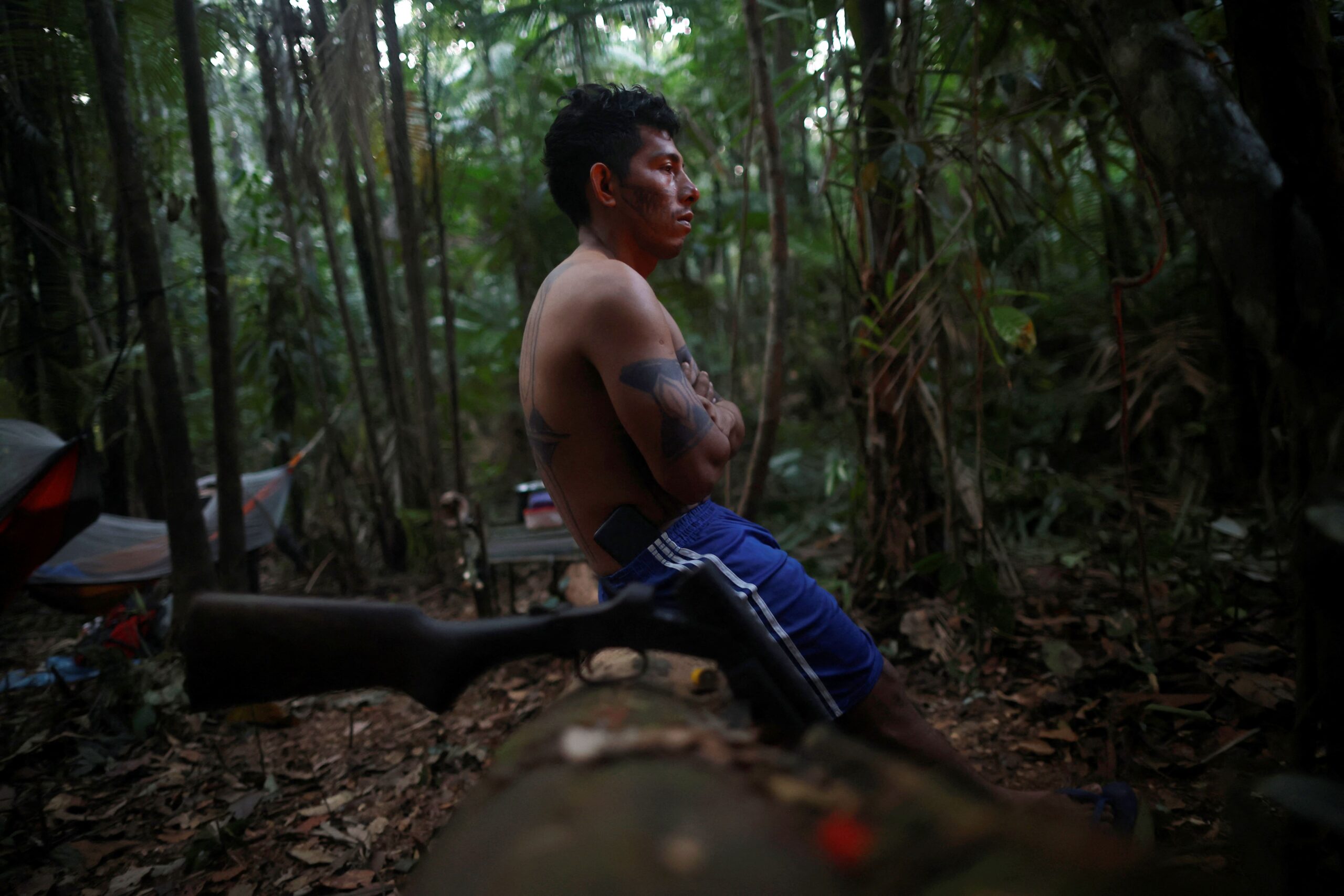

Outside of the official COP process, which “failed to deliver anything meaningful on deforestation”, according to Felix Finkbeiner, founder of Germany-based NGO Plant-for-the-Planet, several voluntary funding initiatives were welcomed by campaigners.
European nations pledged cash to protect rainforest in Africa’s Congo Basin and aid traditional and Indigenous communities living in forested areas, while Brazil’s brainchild, the Tropical Forest Forever Facility (TFFF), also secured several donor promises of support.
Tropical forest fund takes off slowly
The TFFF, which aims to pay tropical countries that conserve their forests with income from financial investments, was also left out of the “Global Mutirão” decision after being featured as an option in an earlier draft.
And despite receiving pledges of funding, almost entirely from countries so far, there are questions over how the fund will operate in practice and whether it will secure the political and financial backing it needs.
“The funding model is realistic in principle”, said Chris Dodwell, head of policy and advocacy at Impax Asset Management – one of the financial firms involved in the fund’s design, adding that investors still needed information on the fund’s reporting process, how the debt will be structured and demonstrated results protecting forests.
“The reality is that the premier investment will only flow once you have got bonds that are being issued, with all of the detail and documentation that you need. The whole concept is always going to have this idea of building over time,” Dodwell told Climate Home.
John Kerry laments lack of fossil fuel transition in COP30 agreement
Still, the TFFF has already received pledges totalling about $7 billion from a handful of countries, though some of them are conditional on it reaching a threshold of support.
That dwarfs the $500 million disbursed by the Green Climate Fund (GCF) for REDD+ forestry projects since 2017, but remains short of the target set by Brazilian officials for the first year of $10 billion in pledges.
Some multilateral banks are considering an investment in the fund, while some donor countries involved in its design – among them Canada, the United Arab Emirates and China – are yet to pledge a contribution.
New Congo Basin finance
In a major financial boost, European nations also pledged to raise $2.5 billion over the next five years for the protection of the Congo Basin, the second-largest rainforest on the planet and the last remaining strong carbon sink.
The pledge scaled up a previous $1.5-billion initiative launched at COP26 in Glasgow to protect the Congo Basin, which trained local populations in sustainable management, helped them secure land rights and funded protected areas, according to implementation reports.
Signatories include France, Germany, Norway, Belgium and the UK, as well as multilateral banks, including the World Bank, African Development Bank, Global Environment Facility and the GCF.
In a similar voluntary initiative, the UK, Germany, Norway and the Netherlands renewed a $1.8-billion pledge to scale up land tenure for Indigenous people and Afro-descendent communities by 2030, which was one of the main Indigenous demands at COP30.
Rachel Pasternak, global lead for forests at The Nature Conservancy, said that these voluntary initiatives are “steps in the right direction”, despite the formal negotiations lagging behind on forests. “While we need to do more, given the geopolitical realities that we’re in, there’s still a lot to celebrate.”
The post With no COP30 roadmap, hopes of saving forests hinge on voluntary initiatives appeared first on Climate Home News.
With no COP30 roadmap, hopes of saving forests hinge on voluntary initiatives
Climate Change
South Africa’s platinum mine dumps get a second look as clean energy lifts demand
Besides the dust that cloaks pathways, windowsills and gardens, the towering grey heaps of discarded rock are another unwelcome reminder of the platinum mine next door to the South African township of Chaneng.
In and around the city of Rustenburg, the low-grade platinum ore that has made South Africa the world’s top producer of the silvery metal creates massive waste piled in large rocky heaps known as tailings. For every tonne of metal extracted, hundreds of tonnes of waste rock is left behind in huge piles.
The transition to cleaner energy system is expected to push up global demand for platinum group metals (PGM) – which include palladium and other precious metals, as well as platinum. They are used in hydrogen-related technologies such as fuel cells and electrolysers that split water molecules as well as in hybrid cars that need catalytic converters to curb pollution.
To secure supplies, mining companies are starting to make use of what was once considered waste.
Efforts to green lithium extraction face scrutiny over water use
Reprocessing mine tailings using new technology can be a more sustainable form of producing minerals and metals needed for the energy transition because it is expected to reduce the size of existing waste heaps and boost output without the need to open new mines, which can cause more environmental destruction and community displacement.
“Tailings reprocessing offers genuine benefits, reducing pressure for new mining [and] addressing existing environmental liabilities,” said Mathikoza Dube, an expert on critical minerals based in Rustenburg.
“It offers the world a pathway to secure supplies of energy transition minerals while remediating waste that’s contaminated communities for generations,” Dube added, cautioning it is not a “magic solution” and should be approached in a way that ensures local communities benefit.
In Chaneng, where the tailings dumps loom over backyards, residents are wary.
“Same theft in new clothes”
They fear the plan to reprocess mining tailings at the neighbouring mine – operated by South African platinum miner Sibanye-Stillwater – is being dressed up as sustainable when in reality it will mean more contamination, blasting, dust and no end to their community’s problems.
Despite decades of mining, unemployment in the area remains high, many people say they never received compensation for the loss of their agricultural land and most households still lack access to basic sanitation infrastructure.
Water testing carried out by SRK Consulting in 2009 found elevated nitrate levels exceeding World Health Organization guidelines in community boreholes, and health practitioners document dramatic increases in respiratory diseases.
“Now they want to dig up the waste piles and call it progress? Show us the ownership papers. Show us the rehabilitation plan. Otherwise, it’s the same theft in new clothes,” said Johannes Kgomo, a community leader.
South Africa’s mining legislation requires that 26% of mining assets are held by historically disadvantaged people including Black South Africans, and Chaneng residents are demanding a stake of 15% to 30% in any tailings operation on their land, allowing them to have a say in how the business is run.
They say that should be granted to them as compensation for the health and environmental problems they have endured as a result of the mine.
The community is also demanding comprehensive water testing and treatment, adequately resourced clinics with respiratory specialists, compensation for destroyed agricultural land, infrastructure repair and long-term health monitoring.
“We are not asking for handouts,” said Gideon Chitanga of the National Union of Mineworkers, which often takes the side of local communities in disputes with companies.
“These people have already paid with their health, their water, their land. That contamination, that suffering – that is their investment. Now they want returns and decision-making power,” Chitanga added.
A spokesperson for Sibanye-Stillwater declined to comment.
A mining industry source, who asked not to be identified, said conversations with community members were ongoing.
“Nobody disputes these communities have suffered. The question is how to structure ownership in a way that’s legally sound, financially viable, and genuinely empowering,” the source said.
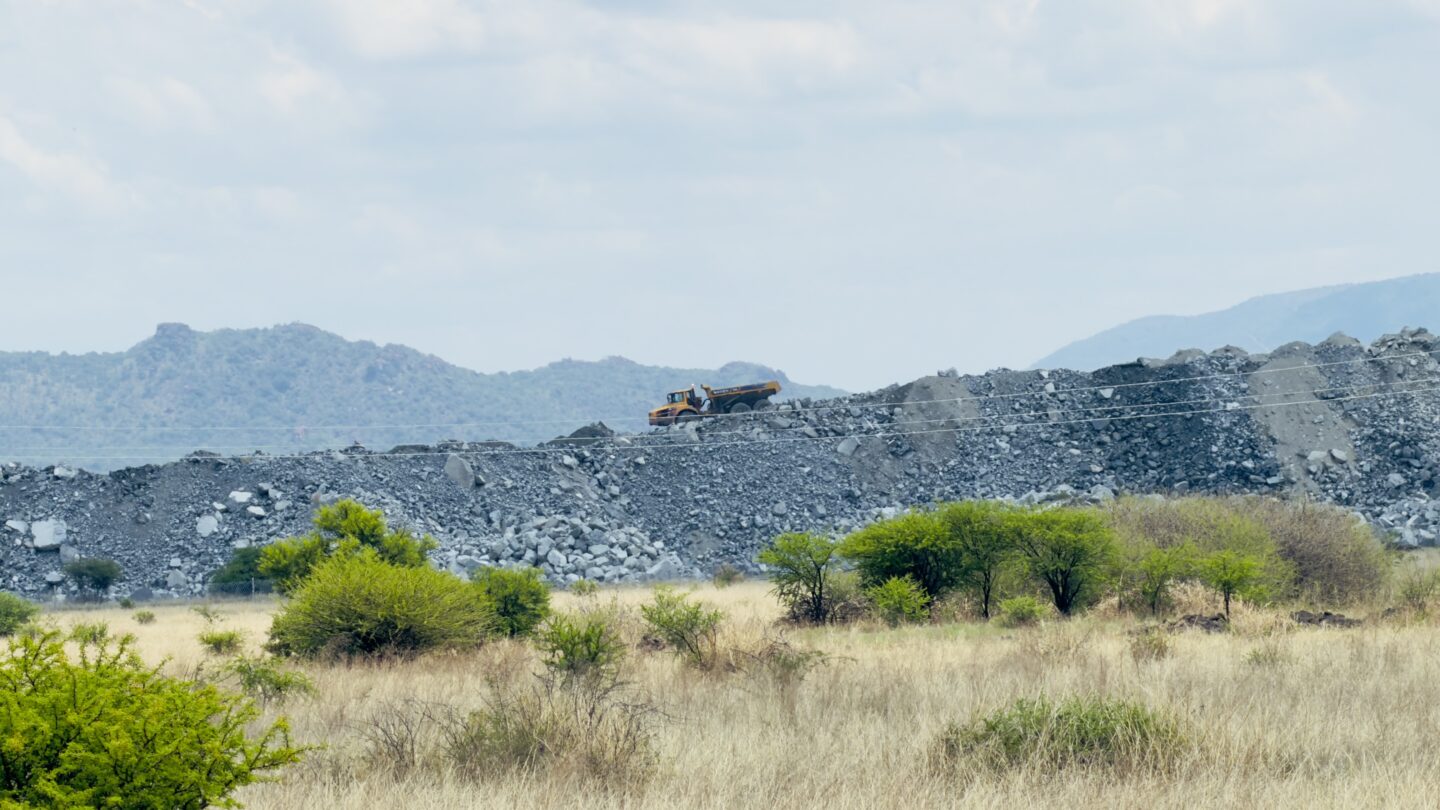
New technology boosts metal recovery in waste
New reprocessing technology has made it economically viable to extract platinum group metals from tailings, and several operations are already underway in South Africa’s platinum mining belt, around the city of Rustenburg.
Sibanye-Stillwater already operates multiple retreatment facilities, processing thousands of tonnes of waste ore monthly.
Another South African miner Tharisa processes chromite from PGM tailings commercially. Chromite is used to obtain chromium, a metal used in the manufacture of wind turbines and some energy storage batteries.
“Historical tailings facilities contain economically viable concentrations that were unrecoverable with older technology,” said Leo Vonopartis from the University of the Witwatersrand’s BUGEMET research programme, which studies the geology of South Africa’s Bushveld Complex mining belt.
Tailings in the area around Rustenburg can contain up to 2.5 grammes per tonne of combined platinum, palladium and rhodium – along with chromite. Vanadium, cobalt and rare earth elements have also been found.
At current prices, which have rallied this year, it is worth extracting the rare metals, despite the challenges.
Breaking with the cycle of extraction and injustice
“The technology exists. The economics work. The question is whether we can structure these projects to genuinely benefit the people who have paid mining’s costs,” a spokesperson for one mining company said, asking not to be named.
Without that, local expert Dube said, the reprocessing of tailings is scarcely better than other forms of mining.
“Reprocessing tailings does not erase the damage that created them. If it is structured as extraction by another name – where companies profit and communities remain marginalised – we have just found a new way to perpetuate old injustices.”
Australia’s COP31 Co-President vows to fight alongside Pacific for a fossil fuel transition
Gesturing toward the tailings dam visible from her yard, Noxolo Mthembu recalls the days when her vegetable patch used to feed the family.
“We used to grow spinach, tomatoes, pumpkins,” she told Climate Home News. “Now nothing grows. The dust kills everything. My children have asthma. My husband died of lung disease at 54.”
Like many of her neighbours, she says any new cycle of mining activity – this time in the name of the clean energy transition – must not repeat the past.
“Show me the ownership papers with our names. Show me the water treatment plant. Show me the clinic with enough staff. Then I will believe this time is different.”
The post South Africa’s platinum mine dumps get a second look as clean energy lifts demand appeared first on Climate Home News.
South Africa’s platinum mine dumps get a second look as clean energy lifts demand
-
Climate Change4 months ago
Guest post: Why China is still building new coal – and when it might stop
-
Greenhouse Gases4 months ago
Guest post: Why China is still building new coal – and when it might stop
-
Climate Change2 years ago
Spanish-language misinformation on renewable energy spreads online, report shows
-

 Greenhouse Gases2 years ago
Greenhouse Gases2 years ago嘉宾来稿:满足中国增长的用电需求 光伏加储能“比新建煤电更实惠”
-
Climate Change Videos2 years ago
The toxic gas flares fuelling Nigeria’s climate change – BBC News
-

 Climate Change2 years ago
Climate Change2 years ago嘉宾来稿:满足中国增长的用电需求 光伏加储能“比新建煤电更实惠”
-

 Carbon Footprint2 years ago
Carbon Footprint2 years agoUS SEC’s Climate Disclosure Rules Spur Renewed Interest in Carbon Credits
-
Renewable Energy5 months ago
US Grid Strain, Possible Allete Sale



